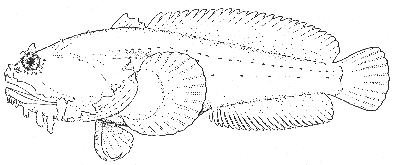Toadfish Opsanus tau (Linnaeus) 1766
[Jordan and Evermann, 1896-1900, p. 2315.]

Figure 274.—Toadfish (Opsanus tau), Woods Hole. Drawing by Louella E. Cable.
Description—
The toadfish, like the sculpins, has a large flat head, round nose, tremendous mouth, tapering body with plump belly, and fanlike pectoral fins. But it differs from all sculpins, and indeed from all other spiny-finned fishes of the Gulf of Maine except the blennies (p. 491) in the location of its ventral fins, which are under the throat well in front of the pectorals ("jugular") instead of below the latter or behind them. And no one could confuse it with any blenny, for it is not only a totally different looking fish, but its dorsal fin is mostly soft rayed while that of the blennies is spiny throughout. The presence of fleshy flaps of irregular outline on the tip of the upper jaw and along the edge of the lower jaw, on the cheeks, and over each eye, gives its head a peculiar wary appearance. Distinctive, also, is the fleshy nature of all its fins and the outline of the dorsal, the soft part of which (26 to 28 rays) is five to six times as long as the spiny part (3 spines), from which it is entirely separated by a deep notch, the two together extending the whole length of the trunk from the nape of the neck nearly to the base of the caudal fin. The anal [page 519] fin (21 or 22 rays) is somewhat shorter than the second (soft) dorsal, orginates under about the eighth ray of the latter, and is similar to it in outline except that its rays are more or less free at their outer ends, especially in its forward half. The caudal fin is rounded; the ventrals covered by thick fleshy skin, are jagged in outline, with the first ray stouter than the others. There is a large open pit of unknown function in the axil of each pectoral fin.
We need only remark, further, that the skin is covered with a thick layer of slimy mucus. The toadfish has no scales; its teeth are large and blunt; and it has two short spines at the upper angle of each gill cover, hidden however, in the thick skin.
Color—
The general ground tint ranges from dark muddy olive green to brown or yellow, darker on back and sides, paler below, and variously and irregularly marked with darker bars and marblings, which may be restricted to head and fins or may extend over the whole fish, belly as well as back. The toadfish, like many other bottom fishes, changes color to match the bottom on which it lies.
Size—
Exceptionally 15 inches long, but few are longer than 12 inches.
Habits—
The toadfish lives in shoal water, and it is resident the year around wherever found, probable becoming torpid in winter in the northern part of its range. It is commonest on sandy or muddy bottom, hiding among eelgrass or under stones where it hollows out dens in which it lies in wait for prey. It is voracious and omnivorous, Vinal Edwards's diet list for it at Woods Hole including sea worms (Nereis), amphipods, shrimps, crabs, hermit crabs, a variety of mollusks both univalve and bivalve, ascidians, squid, and fish fry such as alewives, cunners, mummichogs, menhaden, puffers, sculpins, scup, silversides, smelt, and winter flounders. No doubt any small fish is acceptable.
Toadfish snap viciously when caught, and they often fight among themselves. Like some sculpins they grunt, especially at night or if handled. And despite their clumsy appearance, they can dart out of their hiding places and back again with considerable speed. They are very tenacious of life and can live out of water for an astonishingly long time.
In the northern part of its range the toadfish spawns in June and early July. The very large eggs (about 5 mm. in diameter) are laid in holes under stones, under large shells, in old tin cans, among sunken logs, or among eelgrass, where they adhere in a single layer to whatever serves as a nest, which the male guards during the 3 weeks or so that are occupied by incubation. Even after hatching the tadpole-shaped larvae remain attached to the nest by the yolk sac until the latter is absorbed at a length of 15 to 16 mm. when they break free.[83]
General range—
Shoal water along the east coast of North America from Cuba to Cape Cod, straying northward to Maine.
Occurrence in the Gulf of Maine—
The toadfish is common about Woods Hole and thence westward. But it ventures around Cape Cod so [page 520] seldom that none of the fishermen in Massachusetts Bay of whom we have inquired have seen or heard of it there, nor further north. In fact there are only two definite records of it in the Gulf of Maine: "Maine"[84] and Cohasset on the south shore of Massachusetts Bay, where one (now or formerly in the collection of the Boston Society of Natural History) was caught by Dr. Owen Bryant. There is also one doubtful record for Kittery, Maine.[85]
[83] Ryder (Bull. U. S. Fish Comm., vol. 6, 1887, p. 8) and Gudger (Bull. U. S. Bur. Fish., vol. 28, 1910, pt. 2, pp. 1071-1109, pls. 107-113) describe the breeding habits, eggs, and larvae of the toadfish. For further accounts of its habits see Gill (Smithsonian Miscell. Coll., vol. 48, 1907, pp. 388-427).
[84] Storer, Mem. Amer. Acad., N. Ser., vol. 2, 1846, p. 384, gives no definite locality.
[85] Holmes (2nd Ann Rept. Nat. Hist. Geol. Maine, Pt. 1, 1862, p. 95), "noticed it while standing on the bridge which connects the Navy Yard at Kittery with one of the islands."